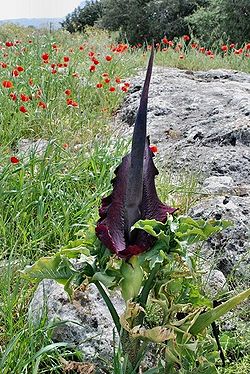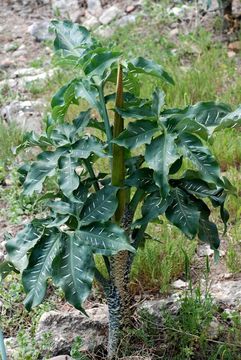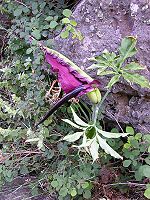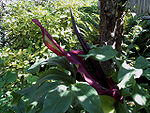Dracunculus
| Dracunculus |
|---|
| Scientific Classification |
|
| Binomial Name |
|
Dracunculus vulgaris |
| The structure of a not fully mature Dracunculus vulgaris |
The Dracunculus vulgaris is a plant native to the Mediterranean region, which is perhaps best known for its putrid smell that it gives off while it is flowering. The plant is grown in gardens as an ornamental because of its beautiful blackish-purple coloring, and large size which can reach up to a six feet tall.[2]
Body Design
When matured, the common Drancunculus has a blackish purple spathe with a black spadix coming up right in the middle of the spathe. The spathe is a leaf-like structure enveloping the spadix until the plant is ready to reproduce. Once the spathe exposes the spadix inside, one can see the purplish black part of the spathe. The colored part of the spathe is on the inside and the part enveloping the spadix. This plant is a monocot.[3] The plant blooms around late spring to early summer and blooms year after year because it is a perennial. When the common Dracunculus is full grown it usually has a height ranging from 4 to 6 feet(1.2 to 1.8 meters). These plants need to be planted with at least one and a half to two feet of space between it and another plant.[4] The plant, before opening the spathe has marble white leaves as well as a marble white stem. The plant may have as few as four leaves, but still has brilliant looking leaves.[5]
Life Cycle
The common Dracunculus is a perennial plant meaning it comes back year after year.[6] The Common Dracunculus starts out as either a berry or a bulb. The plant will continue to grow and then once it is early spring to summer it will reproduce. Once the plant has reproduced it will wait till the next late spring to early summer and attempt to reproduce. So the Dracunculus vulgaris starts out as a bulb or berry and grows, starting out as one shoot coming out of the ground. Then the plant will get leaves the plant has a mix of green and white all over it. The Dracunculus vulgaris will only grow some leaves. Once the season starts to become spring to early summer the plant will start to become more ready to reproduce. Then once the plant is ready to reproduce it will open its spathe. Once the spathe is open it reveals its central spadix. After fertilization, the Dracunculus vulgaris will then start to grow berries. The the plant will wait till the next year and go through the whole process again.[7]
Ecology
Where Dracunculus is grown
Dracunculus vulgaris is native to part of the Mediterranean region, and can be found in places such as Greece, Crete, the Aegean islands, southwest Turkey, the Balkans and some of Mediterranean Europe. This plant has moved to places such as California and can be grown in gardens by gardeners who know how to grow them.The common Dracunculus does not need to live in a tropical climate even though its bright coloring may suggest it does. This plant thrives in a temperate region, and usually grows in a shady place. This plant prefers to grow in moist soil.
Affect on people and animals
The common Dracunculus does not affect people very much except that for a short period of time it smells of rotting flesh. During this period people should avoid getting to close to the plant, but it has been said that someone cannot smell it unless you are really close. The smell does not hurt the person who smells it, it is just very putrid and it would be advisable to stay away from the plant while it gives off it's bad smell.[8] Also, if parts of this plant get eaten, it may be poisonous.[9] So animals do not eat this plant and try to keep much distance between them and the plant. Humans also do not eat this plant but do keep it in gardens because it has interesting colors. Even people who do not live in sunny places will be able to plant the Dracunculus vulgaris because it does not require much sunlight to live.[10]
Reproduction
Bulbs
One way the common Dracunculus reproduces is by producing bulbs. In this reproduction method the plant will just grow out of a bulb and eventually become a mature plant and reproduce like all other common Dracunculus.[11]
Berries
Another, more interesting way the Dracunculus vulgaris will reproduce is by producing berries. The berries that the flower produces resemble an upside down pear, but these berries are much smaller. The way the Dracunculus vulgaris produce berries is really interesting; the plant, once it has matured and is ready to reproduce will open its spathe revealing the spadix and also releasing a putrid smell that attracts flies. The flies will then get stuck inside the spathe of the Dracunculus vulgaris and then get the pollen of the plant all over its body. Once the pollen has collected on the fly the Dracunculus vulgaris will release the flies and let them go and pollinate other Dracunculus vulgaris. Some may think that the Dracunculus vulgaris is a insectivorous plant because it releases such a horrid smell and attracts the flies to it, but the plant is not insectivorous. The Dracunculus vulgaris only attracts the flies to make it so the flies will be able to help reproduce the Dracunculus vulgaris.[12]
References
- Plants Profile. USDA. Web. Accessed May 9, 2012. Author Unknown.
- Dragon Arum (Dracunculus vulgaris). archipelago. Web. Accessed May 9, 2012. Author Unknown.
- Voodoo Lily; aka, Dragon Lily, or Dragon Arum. Paghat's Garden. Web. Accessed May 9, 2012. Author Unknown.
- PlantFiles: Dragon Flower, Dragon Arum, Voodoo Lily, Black Lily Dracunculus vulgaris. Dave's Garden. Web. Accessed May 9, 2012. Author Unknown.
- Dracunculus vulgaris. flowers of chania. Web. Accessed May 9, 2012. Author Unknown.




